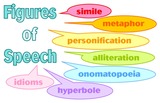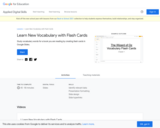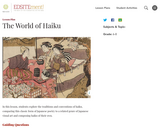
Students learn how to annoate text in Google Docs.
- Subject:
- English Language Arts
- Material Type:
- Lesson Plan
- Provider:
- Provider Set:
- Google for Education
- Author:
- Google Applied Digital Skills
- Date Added:
- 08/30/2021

Students learn how to annoate text in Google Docs.

My World Media Literacy, developed in partnership by BBC Learning, BBC World Services, and Microsoft, is a free educational platform for students ages 11-14 designed with the goal of increasing global media literacy and the evaluation of information presented in modern journalism. Featuring ten 45-minute lesson plans, each with activities and a companion video, these 21st century resources increase students’ critical thinking skills needed to be responsible consumers of news while inspiring them to become citizen journalists in order to navigate the news and form their own opinions.

Uncover the meaning and historical origins of the popular idiom “the bee’s knees” with this video from Say What?! Travel back in time and discover how people used whimsical expressions like "the bee's knees" to describe excellence during The Roaring Twenties. With this video, students will gain insight into the intriguing world of idiomatic expressions, language evolution, and the stories behind the sayings we use every day!
This resource includes teaching tips, discussion questions, vocabulary, and a "Bee's Knees Hive" activity.

This is a context clue lesson plan. It includes a pre-test and post-test and strategies to teach context clues.

Uncover the meaning and historical origins of the popular idiom “crocodile tears” with this video from Say What?! Explore the connection between crocodiles and fake crying, as well as how the idiom has been used throughout history, including in the works of the legendary playwright, William Shakespeare.
This resource includes teaching tips, discussion questions, handouts, vocabulary list, and a "Cry or Lie" activity.

What's that sound? Students participate in a Directed Listening-Thinking Activity (DLTA) using "The Tell-Tale Heart," make predictions, and respond in the form of an acrostic poem or comic strip.

Students will engage with primary source documents to explore the reasons behind memorializing people in public art. Students will craft written or oral statements to support an argument in favor of installing a statue of Dr. Martha Hughes Cannon, Philo T. Farnsworth, or Brigham Young in National Statuary Hall.

This lesson plan was created as a way for students to show their understanding of six different types of figurative language. Students will need to have learned about simile, metaphor, hyperbole, alliteration, onomatopoeia, and personification. Students will also need to have learned about citing sources for images found online. Image License: Attribution-NonCommercial-NoDerivs 2.0 Generic (CC BY-NC-ND 2.0)

As of today there are 29 different books, many of them challenged or banned in more than one location. The 29 books are by 31 different Native authors and illustrators from 22 distinct Native Nations.

Dive into the meaning and history of the idiom “it’s raining cats and dogs” with this video from Say What?! Explore possible origins featuring Vikings, sailors, poets, straw roofs, and old English.
Support materials include teaching tips, discussion questions, vocabulary, and an activity where students create a corresponding image and caption for one of the origin stories from the video.

Students will create a Slide deck to learn new vocabulary.

Explore the meaning of the idiom “let the cat out of the bag” through present day conversation examples alongside a look into the past, in this video from Say What?! With visuals and a story that takes students to “Ye Olde Marketplace,” students discover this idiom's possible origin. Huzzah!
This resource includes teaching tips, discussion questions, vocabulary, and a critical thinking activity where students practice comparing and contrasting and using descriptive language.

Trace the role of messenger birds throughout history and learn the meaning of the idiom “a little bird told me,” in this video from Say What?! From Ancient Egypt to World War I, this video combines conversational use of the idiom with written stories and legends to showcase its meaning.
This resource includes teaching tips, discussion questions, vocabulary, and a research and writing activity that prompts students to reimagine the “messenger bird.”

Learn about the idiom "red herring" in this video from Say What?! that explains how the phrase signifies something that diverts attention from what's truly important. Students will explore its historical origins among British fishermen and its integration into storytelling and popular culture.
This resource includes teaching tips, discussion questions, vocabulary, and a critical thinking activity where students must identify “red herrings” that are a distraction from the main goal.

Learn about the idiom “straight from the horse’s mouth” and how it means getting the most accurate information from someone who knows it best, or firsthand, in this video from Say What?! Students will explore its origin and importance through animated stories about the past and its use today.
This resource includes teaching tips, discussion questions, and a critical thinking activity where students must identify which source of information would be considered the most accurate or “straight from the horse’s mouth.”

Learn how educators in upper elementary, middle grades, and high school can support their English learners' vocabulary development with these strategies.

What is a gag rule? Why was a gag rule imposed by the House of Representatives? What are the implications for the country if the House of Representatives should pass other gag rules?

Uncover the meaning and historical origins of the popular idiom “when pigs fly” with this video from Say What?! Through engaging animations, students will learn about this quirky expression that is often used to convey something that is highly unlikely to happen. The video explores similar idioms that are used in different languages and cultures, providing insight into the creative ways people express the idea of impossibility. The video also delves into the history of the idiom, tracing its origins back over 400 years!
This resource includes teaching tips, discussion questions, vocabulary, and a critical thinking activity in which students brainstorm possible "when pigs fly" scenarios.

The Iris Center provides a wealth of resources for Inclusive Literacy instruction for students of all grade levels. The Iris Center offers modules for content area teachers who are often frustrated by the poor reading abilities of many of their students. it is important for content-area teachers to understand where reading breakdowns occur and how they can effectively and efficiently teach the skills necessary for students to read and understand complex, content-area text.

Explore the traditions and conventions of haiku and compare this classic form of Japanese poetry to a related genre of Japanese visual art.